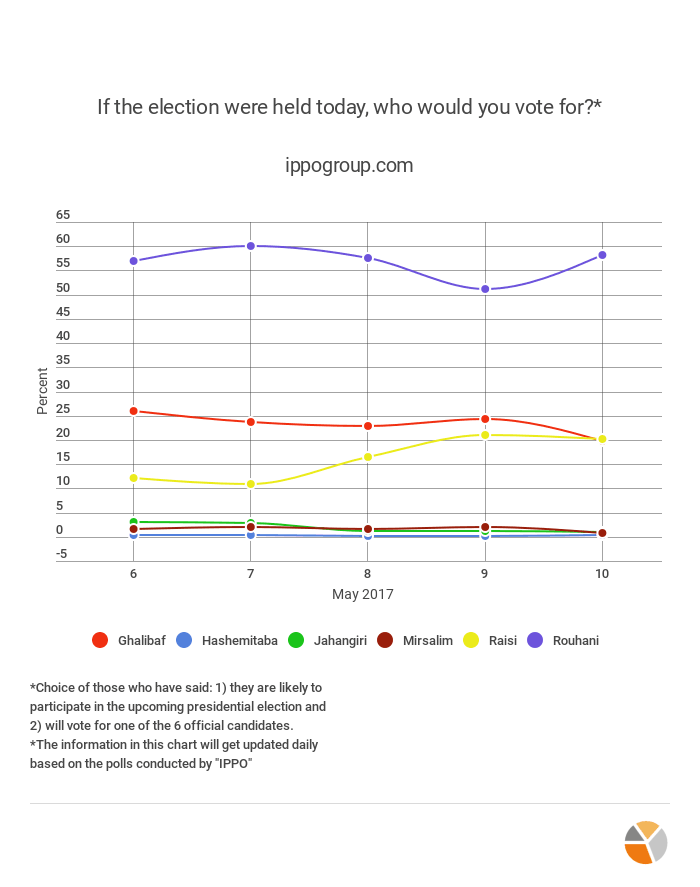Poll5
iPPO Group
2017-05-12T02:25:07+00:00
The Vote to Elect the Iranian President
The rating of Hassan Rouhani, the leading candidate, shows a significant increase today. As of now, around 58% of respondents who say 1) they will definitely or likely participate in the May 2017 election and 2) are inclined to vote for one of the six running candidates, have voted for Hassan Rouhani as their first choice.
Counter to Rouhani’s gain, Mohammad Bagher Ghalibaf’s votes have decreased by 5%. Ebrahim Raisi’s rating has not changed drastically. Therefore, it seems that the race between Rouhani and Raisi is taking the place of the race between Rouhani and Ghalibf (see the top chart).
Will this pattern continue to the Election Day? Only the results of polls in the coming days could help clarify and forecast the pattern of the final race.
The numbers of undecided voters are falling, yet still in less than ten days to Election Day 30% of respondents are undecided and 14% do not express a clear opinion as to whom they will vote for (Chart to the left).
Second Choice Voter Preferences
In the past five days respondents were asked: “if you were to change your mind before the Election Day, who else will you vote for instead of your first choice?” About one-fifth of the voters insist on only voting for their first choice and say they will not vote for any other candidate. Ghalibaf’s rating as the second choice candidate is still growing but at a slower rate compared to earlier polls. The ratings of other candidates have not changed drastically.
The Most Unfavorable Candidate
Most respondents still prefer not to indicate which candidate is so unfavorable that they will not vote for him under any circumstances. In other words, almost 48% of the respondents either say that no one among the candidates is the most unpopular or that they cannot or do not wish to name the most unfavorable candidate.
The ranking for the most unfavorable candidate is similar to the ranking of the most favorable candidate. The highest rating of unfavorability is of Hassan Rouhani with 8% and after him Raisi (%4) and Ghalibaf (4%). Jahangiri with less that 1% of the unpopularity vote continues to stands as the least unfavorable candidate.
Respondents’ Prediction of Candidates’ Victory
Respondents’ forecasting of the election results will portray the election milieu and distinguish between respondents’ own inclination and their predictions of the final outcome. Comparing the candidates leading in the first to third positions, the only development in the past five days is that the chance of winning the presidency for Ghalibaf and Raisi has shifted. As of now, the respondents think that Ghalibaf has less chance of winning this election when compared to Raisi. Rouhani is still the leading candidate when it comes to respondents’ predictions and most voters think that he has a greater chance of becoming president.
Voter Turnout
The rates of participants who are going to vote have remained more or less the same in the past five days. Around 70% of respondents say they are likely or very likely to vote in the May 2017 presidential election. In contrast, 14% say there is little chance or very little chance that they will participate in the elections. Besides the 7% of respondents that say they are somewhat likely to participate in the elections, 5% of the respondents have not yet reached a decision with regards to participation.
Projections of election participation rates in polls such as this one does not neatly translate to voter turnout rate on the day of the election. Projections of the voter turnout in polls are often more than the actual turnout on the day of the election; this is not unique to the Iranian context and is relevant to all pre-election polling.
Following Presidential Debates
Following of the presidential debates to some extent divides the respondents to two groups of relatively same weight. However, more respondents are following the debates after the second round of debates was aired from IRI broadcasting television and radio platforms last Friday 5 May. About 54% of the respondents say they have followed the election debates and 42% of them say that they have not been following the debates.
Survey Methodology:
-
This polling was carried out at a national level in Iran from 7 May 2017 to 10 May 2017 and reported on a four-day rolling average basis.
-
The interviews were conducted via phone. Interviewers were trained – both for general skills of phone polling and for the specific needs of this survey. The interviewers were selected post training after passing an interviewing skills exam.
-
The sample size was 1189 Iranians, 18 years and older, who were residing in Iran and were selected randomly.
-
Sampling methodology is a two-stage proportional sampling. It’s on the basis of each of the service operators’ market share and then simple random sampling.
-
Assuming maximum variation, the results of this survey can generalize to the whole of the 18 years and older Iranian (resident in Iran) with a margin of error of ±2.82 to ±3.75 for the 95% confidence interval (based on responses to questions).
-
The data were weighted based on the last available National Iranian Census (2011) with gender, age group and place of residence (urban/rural) as weighting variables.
-
Farsi native speaking interviewers conducted the interviews during daylight hours, local time.
-
The results of each interview was assessed twice by the interviewer and the supervising team – in terms of respondent’s trust in the interviewer and the interviewer’s assessment of the respondents’ honesty.
-
Those respondents who had received very low scores for trust and honesty have been removed from the random sample.
فارسی



